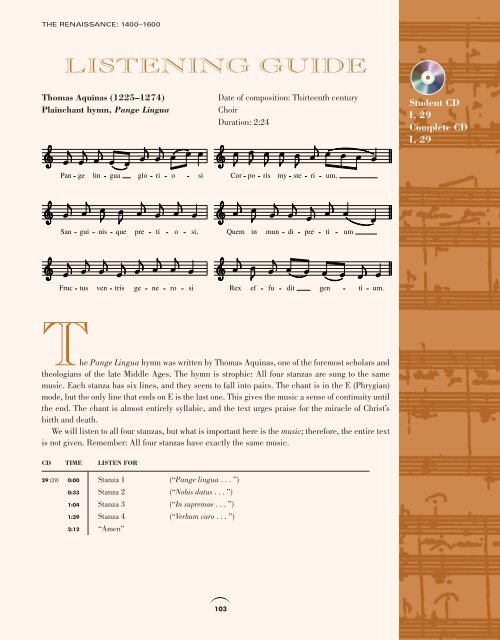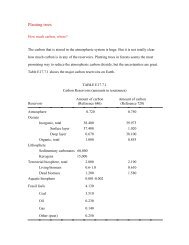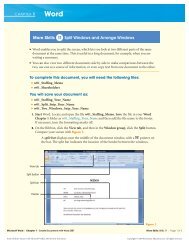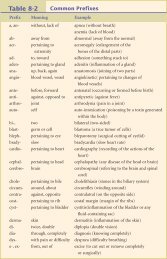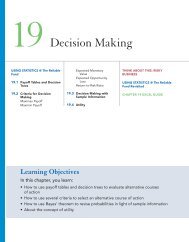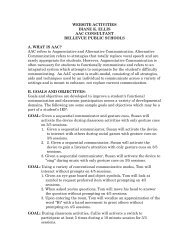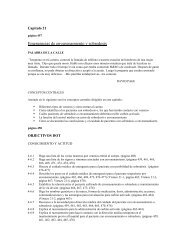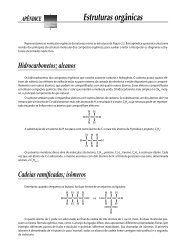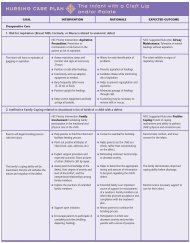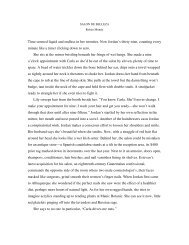LISTENING GUIDE
LISTENING GUIDE
LISTENING GUIDE
Create successful ePaper yourself
Turn your PDF publications into a flip-book with our unique Google optimized e-Paper software.
YUDKMC05_096-118hr 11-01-2007 14:36 Page 103<br />
THE RENAISSANCE: 1400–1600<br />
<strong>LISTENING</strong> <strong>GUIDE</strong><br />
Thomas Aquinas (1225–1274)<br />
Plainchant hymn, Pange Lingua<br />
Date of composition: Thirteenth century<br />
Choir<br />
Duration: 2:24<br />
Pan ge lin gua glo ri o si Cor po ris my ste ri um,<br />
San gui nis que pre ti o si, Quem in mun di pre ti um<br />
Fruc tus ven tris ge ne ro si Rex ef fu dit gen ti um.<br />
The Pange Lingua hymn was written by Thomas Aquinas, one of the foremost scholars and<br />
theologians of the late Middle Ages. The hymn is strophic: All four stanzas are sung to the same<br />
music. Each stanza has six lines, and they seem to fall into pairs. The chant is in the E (Phrygian)<br />
mode, but the only line that ends on E is the last one. This gives the music a sense of continuity until<br />
the end. The chant is almost entirely syllabic, and the text urges praise for the miracle of Christ’s<br />
birth and death.<br />
We will listen to all four stanzas, but what is important here is the music; therefore, the entire text<br />
is not given. Remember: All four stanzas have exactly the same music.<br />
CD TIME LISTEN FOR<br />
29 (29) 0:00 Stanza 1 (“Pange lingua ... ”)<br />
0:33 Stanza 2 (“Nobis datus ... ”)<br />
1:04 Stanza 3 (“In supremae ... ”)<br />
1:39 Stanza 4 (“Verbum caro ... ”)<br />
2:12 “Amen”<br />
103<br />
Student CD<br />
I, 29<br />
Complete CD<br />
I, 29
YUDKMC05_096-118hr 11-01-2007 14:36 Page 104<br />
Student CD<br />
I, 30<br />
Complete CD<br />
I, 30<br />
<strong>LISTENING</strong> <strong>GUIDE</strong><br />
Josquin Desprez (c. 1440–1521)<br />
Kyrie from the Pange Lingua Mass<br />
TENORS<br />
104<br />
Date of composition: c. 1520<br />
Sopranos, altos, tenors, basses<br />
Duration: 2:51<br />
CHAPTER 5<br />
All of the three basic characteristics of Josquin’s style that we have discussed may be<br />
heard in the opening Kyrie of Josquin’s Pange Lingua Mass:<br />
1. Simple imitation: A point of imitation introduces each short melodic phrase.<br />
2. Overlapping cadences: Just as the first group is completing its phrase and moving into a<br />
cadence, a second group enters, and so on.<br />
3. Paired imitation: One pair of voices sings a phrase of imitation, then another pair enters.<br />
Let us first look at the phrase that provides the material for the first point of imitation. It is<br />
derived from the first phrase of the plainchant hymn. Notice, however, that Josquin adds a short<br />
turning passage between the last two notes to provide intensity and drive to the cadence. Notice, too,<br />
the rhythm that Josquin has applied to the notes. It starts out with long notes (which stress the characteristic<br />
E–F half step of the Phrygian mode) and increases in motion until just before the end. The<br />
meter of this music is also very flexible. Composers of this era did not use measures or bar lines
YUDKMC05_096-118hr 11-01-2007 14:36 Page 105<br />
THE RENAISSANCE: 1400–1600<br />
(as you can see from the facsimile of the original score). This creates a very fluid sound without the<br />
regularly recurring accents that occur in later music.<br />
The movement as a whole has three main sections:<br />
1. Kyrie eleison.<br />
2. Christe eleison.<br />
3. Kyrie eleison.<br />
Each section begins with a new point of imitation, and all are derived from the original hymn.<br />
The “Christe” section is based on the third and fourth lines of the hymn, the final “Kyrie” section<br />
on the fifth and sixth lines. Toward the end of the last section, Josquin adds new rhythmic material<br />
to create a strong drive to the final cadence.<br />
CD TIME LISTEN FOR<br />
30 (30) 0:00 Kyrie eleison (Based on opening of hymn melody.) Tenors and basses; cadence<br />
overlaps with entry of altos. Sopranos enter before final<br />
cadence.<br />
0:45 Christe eleison (Based on lines 3 and 4 of hymn melody.) Paired imitation,<br />
overlapping entries.<br />
2:02 Kyrie eleison (Based on lines 5 and 6 of hymn melody.) Sopranos, altos, tenors,<br />
basses enter in turn; increase in activity before final cadence.
YUDKMC05_096-118hr 15-01-2007 17:30 Page 109<br />
THE RENAISSANCE: 1400–1600<br />
<strong>LISTENING</strong> <strong>GUIDE</strong><br />
Giovanni Pierluigi da Palestrina (c. 1525–1594)<br />
Motet, Exsultate Deo<br />
Date of composition: 1584<br />
Sopranos, altos I, altos II, tenors, basses<br />
Duration: 2:24<br />
The motet Exsultate Deo was first published in Palestrina’s fifth book of motets in 1584.<br />
This book contains twenty-one motets written for five voices. The text is from Psalm 81. Palestrina<br />
uses only the first three lines of the psalm.<br />
Exsultate Deo adiutori nostro, Sing out in praise of God our refuge,<br />
iubilate Deo Iacob. acclaim the God of Jacob.<br />
Sumite psalmum et date tympanum, Raise a melody; beat the drum,<br />
psalterium iucundum cum cithara. play the tuneful lyre and harp.<br />
Buccinate in neomenia tuba, Blow the trumpet at the new moon,<br />
insigni die solemnitatis vestrae. and blow it at the full moon on the day of your<br />
solemn feast.<br />
In his setting, Palestrina concentrates only on these exuberant opening<br />
verses of the psalm, rather than the fierce later ones. The music is bright<br />
and joyful, filled with dotted rhythms and running eighth-note patterns,<br />
which help to enliven the work. In addition, the composer uses some<br />
word-painting (echoing the meaning of words in music), such as on the<br />
opening word “Exsultate,” where the musical line rises triumphantly.<br />
Ex sul ta te De o<br />
With five independent musical lines, the number of possible combinations is large, and Palestrina<br />
constantly varies the texture of his music. The clearest examples of this variation are when the<br />
sopranos drop out briefly, leaving only the lower voices, or (on the words “psalterium iucundum”—<br />
“tuneful lyre”) when only three voices are sounding. Exsultate Deo is full of imitation, but Palestrina<br />
points up the entrance of new lines of text by having them sung homophonically by a pair of voices,<br />
which adds an underlying structure to the work as a whole. Cleverly, he departs from this technique<br />
toward the end of the motet on the words “Buccinate” (“blow”) and “tuba” (“trumpet”), where there<br />
is very close imitation, suggesting the echoing of trumpet blasts.<br />
This performance is by the choir of Christ Church Cathedral, Oxford, England. This choir, which has<br />
been in continuous existence since the early sixteenth century, is made up of the same distribution of<br />
voices as it was originally: sixteen boys and twelve men. So all the high voices you hear are those of boys.<br />
109<br />
Student CD<br />
I, 31<br />
Complete CD<br />
I, 31
YUDKMC05_096-118hr 11-01-2007 14:36 Page 110<br />
CD TIME LISTEN FOR<br />
CHAPTER 5<br />
31 (31) 0:00 Exsultate Deo Sing out in praise of [Imitation in pair of upper voices<br />
adiutori nostro, God our refuge, alone; rising line on “Exsultate.”]<br />
0:11 [Pair of lower voices. Cadence in<br />
all five voices; overlaps with:]<br />
0:28 iubilate Deo Iacob. acclaim the God of [Many entries, suggesting<br />
Jacob. a crowd “acclaiming.”]<br />
0:37 [Lower voices.]<br />
0:49 Sumite psalmum et Raise a melody; beat [Quite homophonic, becoming<br />
date tympanum, the drum, more imitative. Note dotted<br />
rhythm on “tympanum.”]<br />
1:04 psalterium iucundum play the tuneful lyre [Elaborate flowering of the voices<br />
cum cithara. and harp. on “iucundum” (“tuneful”).]<br />
32 (32) 0:00 Buccinate in Blow the trumpet [Multiple echoes on “Buccinate;”<br />
neomenia tuba, at the new moon, homophonic climax on “neomenia.”]<br />
0:13 [Running echoes on “tuba.”]<br />
0:23 insigni die and blow it at the full [Slower, lower, more “solemn.”]<br />
solemnitatis moon on the day of<br />
vestrae. your solemn feast.
YUDKMC05_096-118hr 11-01-2007 14:36 Page 112<br />
Student CD<br />
I, 33<br />
Complete CD<br />
I, 33<br />
<strong>LISTENING</strong> <strong>GUIDE</strong><br />
Thomas Morley (1557–1602)<br />
Two English Madrigals<br />
Date of composition: 1595<br />
Two sopranos (Sweet Nymph Come to Thy Lover);<br />
two baritones (Fire and Lightning)<br />
Duration: 2:31<br />
The texts for these short pieces were probably written by Morley himself. Each one contains<br />
picturesque images, which the music captures beautifully. The first madrigal, Sweet Nymph,<br />
compares the lover, singing his song to his beloved, to a nightingale, a favorite image for composers.<br />
The second, Fire and Lightning, uses the imagery of thunder and storms to describe the “stormy”<br />
nature of love. It is lively and frenetic, with a kicker at the end. Both are primarily imitative, with<br />
very close imitation in some sections to liven up the proceedings or to intensify the sound. The very<br />
last line of Fire and Lightning is suddenly homophonic to draw attention to the sting at the end. This<br />
last line also exploits antithesis (“fair”/“spiteful”) to make its effect.<br />
Both madrigals have such short texts that there are many repetitions of each phrase, and you will<br />
hear many instances of word-painting. The fine performances here are by students Sarah Pelletier<br />
and Suzanne Ehly, sopranos, and faculty members William Sharp and Mark Aliapoulios, baritones,<br />
of the Boston University School for the Arts.<br />
CD TIME LISTEN FOR<br />
33 (33) 0:00 Sweet nymph come to thy lover, Imitation.<br />
0:12 Lo here alone our loves we Touches of homophony on<br />
may discover, “Lo here alone.”<br />
0:20 (Repeat of first two lines)<br />
0:39 Where the sweet nightingale Imitation; high notes and<br />
with wanton gloses, close harmony on “gloses” [trills].<br />
0:49 Hark, her love too discloses. High notes, very close imitation,<br />
especially last time through.<br />
1:03 (Repeat of last two lines)<br />
34 (34) 0:00 Fire and lightning from heaven fall Lively; very close imitation.<br />
0:08 And sweetly enflame that heart Smooth descending scales on<br />
with love arightful, “sweetly.”<br />
0:16 (Repeat of first two lines)<br />
CHAPTER 5<br />
0:31 Of Flora my delightful, Scales in opposite direction on “delightful.”<br />
0:45 So fair but yet so spiteful. Last time through: homophonic, close<br />
pungent harmony, dissonance on “spite-,”<br />
incomplete sound on “ful.”<br />
0:47 (Repeat of last two lines)<br />
112
YUDKMC05_096-118hr 11-01-2007 14:36 Page 114<br />
Student CD<br />
I, 35<br />
Complete CD<br />
I, 35<br />
<strong>LISTENING</strong> <strong>GUIDE</strong><br />
Giovanni Gabrieli (c. 1555–1612)<br />
Canzona Duodecimi Toni<br />
114<br />
Date of composition: 1597<br />
Two brass choirs<br />
Duration: 3:53<br />
CHAPTER 5<br />
This work by Giovanni Gabrieli is divided into several sections and contrasts two brass<br />
“choirs,” which are heard in dialogue. As in Josquin’s Pange Lingua Mass, the music is pushed forward<br />
by overlapping cadences, one choir beginning as the previous choir ends. Sometimes the two<br />
choirs play together. The piece features dynamic contrasts of loud and soft, which are characteristic<br />
of late Renaissance and early Baroque music. A special effect involving dynamic contrast is “echo,”<br />
in which the exact repetition of a phrase at a lower volume suggests distance.<br />
The canzona is full of varied rhythmic patterns, but the most pervasive is the “canzona rhythm,”<br />
LONG-short-short (hqq), which you will hear throughout the piece, in fast and slow tempos.<br />
CD TIME LISTEN FOR<br />
Introduction<br />
35 (35) 0:00 Both brass choirs. Fairly slow, medium loud; canzona rhythm is prominent.<br />
Section 1<br />
36 (36) 0:15 Choir I. Faster tempo, same musical motive and rhythm, faster<br />
tempo, homophonic.<br />
0:20 Choir II, growing louder.<br />
Section 2<br />
0:27 Both choirs, loud, featuring flourishes by trumpets in imitation; cadence.<br />
37 (37) 0:43 Second idea, quieter, mostly homophonic, echoes, passages of imitation<br />
between choirs, lively rhythms; cadence.<br />
Section 3<br />
38 (38) 1:26 Third idea, loud, mostly homophonic, echoes, both choirs.<br />
1:43 Trumpet flourishes, cadence.<br />
1:49 Canzona rhythm; close imitation, cadence.<br />
Section 4<br />
39 (39) 2:10 Fourth idea, quiet, canzona rhythm, lots of imitation between choirs,<br />
cadence.<br />
2:35 Multiple echoes, from loud to soft, between choirs; crescendo . . .<br />
3:02 Final idea, both choirs loud, leading to big climax.
YUDKMC05_096-118hr 11-01-2007 14:36 Page 115<br />
THE RENAISSANCE: 1400–1600<br />
<strong>LISTENING</strong> <strong>GUIDE</strong><br />
Tielman Susato (fl. 1543–1561)<br />
Ronde and Saltarelle<br />
115<br />
Date of composition: 1551<br />
Recorders and percussion<br />
Duration: 1:52<br />
This example is a dance pair written by the Flemish composer and publisher Tielman<br />
Susato. The ronde and saltarelle are both Renaissance dances in binary form. On the repeats, the<br />
melodies are occasionally ornamented with trills and decorative figures.<br />
The two dances use the same melody, but the ronde is in duple meter, whereas the saltarelle is in<br />
triple meter; the effect of the meter change is dramatic.<br />
CD TIME LISTEN FOR<br />
Ronde<br />
(40) 0:00<br />
[duple meter: recorders and drum]<br />
First phrase:<br />
0:14 Repeat (ornamented)<br />
0:29 Second phrase (higher):<br />
0:36 Repeat (ornamented)<br />
Saltarelle<br />
(41) 0:43<br />
[triple meter: recorders and tambourine]<br />
First phrase:<br />
1:05 Repeat (ornamented)<br />
1:26 Second phrase (higher):<br />
1:37 Repeat (ornamented)<br />
etc.<br />
etc.<br />
etc.<br />
etc.<br />
Complete CD<br />
I, 40


